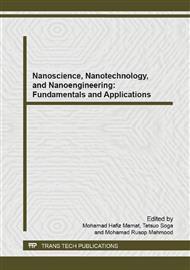[1]
A.E. Jimenez-Gonzalez, J.A. Soto Urueta, R. Suarez-Parra, Optical and electrical characteristics of aluminum-doped ZnO thin films prepared by sol-gel technique, Journal of Crystal Growth, 192 (1998) 430-438.
DOI: 10.1016/s0022-0248(98)00422-9
Google Scholar
[2]
H.S. Park, H.W. Shin, D.H. Yun, H.K. Hong, C.H. Kwon, K. Lee, S.T. Kim, Tin oxide micro gas sensor for detecting CH3SH, Sensors and Actuators: B. Chemical, 25 (1995) 478-481.
DOI: 10.1016/0925-4005(95)85102-x
Google Scholar
[3]
Y.G. Seol, T.Q. Trung, O.J. Yoon, I.Y. Sohn, N.E. Lee, Nanocomposites of reduced graphene oxide nanosheets and conducting polymer for stretchable transparent conducting electrodes, Journal of Materials Chemistry, 22 (2012) 23759-23766.
DOI: 10.1039/c2jm33949h
Google Scholar
[4]
B. Danouj, S.A. Tahan, E. David, Using a new generation of piezoelectric sensors for partial discharge detection, Measurement: Journal of the International Measurement Confederation, 46 (2013) 660-666.
DOI: 10.1016/j.measurement.2012.09.005
Google Scholar
[5]
C.P. Lungu, M. Futsuhara, O. Takai, M. Braic, G. Musa, Noble gas influence on reactive radio frequency magnetron sputter deposition of Tin films, Vacuum, 51 (1998) 635-640.
DOI: 10.1016/s0042-207x(98)00264-4
Google Scholar
[6]
P. Souletie, S. Bethke, B.W. Wessels, H. Pan, Growth and characterization of heteroepitaxial ZnO thin films by organometallic chemical vapor deposition, Journal of Crystal Growth, 86 (1990) 248-251.
DOI: 10.1016/0022-0248(90)90724-y
Google Scholar
[7]
S. Major, A. Banerjee, K.L. Chopra, Optical and electronic properties of zinc oxide films prepared by spray pyrolysis, Thin Solid Films, 125 (1985) 179-185.
DOI: 10.1016/0040-6090(85)90411-0
Google Scholar
[8]
L. Xu, X. Li, Influence of Fe-doping on the structural and optical properties of ZnO thin films prepared by sol–gel method, Journal of Crystal Growth, 312 (2010) 851-855.
DOI: 10.1016/j.jcrysgro.2009.12.062
Google Scholar
[9]
B. Deng, Z. Guo, H. Sun, Theoretical study of Fe-doped p-type ZnO, Applied Physics Letters, (2010), 96.
Google Scholar
[10]
B. Panigrahy, M. Aslam, D. Bahadur, Effect of Fe doping concentration on optical and magnetic properties of ZnO nanorods, Nanotechnology, (2012), 23.
DOI: 10.1088/0957-4484/23/11/115601
Google Scholar
[11]
T.L. Phan, S.C. Yu, R. Vincent, H.M. Bui, T.D. Thanh, V.D. Lam, Y.P. Lee, Influence of Mn doping on structural, optical, and magnetic properties of Zn1-xMnxO nanorods, Journal of Applied Physics, (2010), 108.
DOI: 10.1063/1.3478709
Google Scholar
[12]
Z.C. Chen, L.J. Zhuge, X.M. Wu, Y.D. Meng, Initial study on the structure and optical properties of Zn1-xFexO films, Thin Solid Films, 515 (2007) 5462-5465.
DOI: 10.1016/j.tsf.2007.01.015
Google Scholar
[13]
K. Sato and H. Katayama-Yoshida, Ferromagnetism in a transition metal atom doped ZnO, Physica E: Low-Dimensional Systems and Nanostructures, 10, (2001), 251-255,.
DOI: 10.1016/s1386-9477(01)00093-5
Google Scholar
[14]
X. X. Wei, C. Song, K. W. Geng, F. Zeng, B. He, and F. Pan, Local Fe structure and ferromagnetism in Fe-doped ZnO films, Journal of Physics Condensed Matter, 18, (2006), 7471-7479.
DOI: 10.1088/0953-8984/18/31/037
Google Scholar
[15]
Q. Humayun, M. Kashif and U. Hashim, Area-Selective ZnO Thin Film Deposition on Variable Microgap Electrodes and Their Impact on UV Sensing, Journal of Nanomaterials, 2013, (2013), 5.
DOI: 10.1155/2013/301674
Google Scholar
[16]
Q. Humayun, M. Kashif and U. Hashim, ZnO thin film deposition on butterfly shaped electrodes for ultraviolet sensing applications, Optik - International Journal for Light and Electron Optics, 124, (2013), 5961-5963.
DOI: 10.1016/j.ijleo.2013.04.119
Google Scholar
[17]
Q. Humayun, M. Kashif, and U. Hashim, Structural, Optical, Electrical, and Photoresponse Properties of Postannealed Sn-Doped ZnO Nanorods, Journal of Nanomaterials, 2013, (2013), 8.
DOI: 10.1155/2013/792930
Google Scholar
[18]
Q. Humayun, M. Kashif, U. Hashim, and A. Qurashi, Selective growth of ZnO nanorods on microgap electrodes and their applications in UV sensors, Nanoscale research letters, 9, (2014), 29.
DOI: 10.1186/1556-276x-9-29
Google Scholar
[19]
Pandiyarajan and B. Karthikeyan, Optical properties of annealing induced post growth ZnO: ZnFe2O4 nanocomposites, Spectrochimica Acta Part A: Molecular and Biomolecular Spectroscopy, 106, (2013), 247-252.
DOI: 10.1016/j.saa.2012.12.077
Google Scholar
[20]
Ahsanulhaq Q, Kim J, Lee J, Hahn Y: Electrical and gas sensing properties of ZnO nanorod arrays directly grown on a four-probe electrode system. Electrochem Commun (2010), 12:475–478.
DOI: 10.1016/j.elecom.2010.01.023
Google Scholar
[21]
Ahsanulhaq Q, Kim J-H, Hahn Y-B: Controlled selective growth of ZnO nanorod arrays and their field emission properties. Nanotechnology (2007), 18:485307.
DOI: 10.1088/0957-4484/18/48/485307
Google Scholar
[22]
Q. Humayun, M. Kashif, and U. Hashim, Fabrication and characterization of a single-bridge nanorod between microgap electrodes, Microelectronics International, 31, (2014), 104-107.
DOI: 10.1108/mi-12-2012-0084
Google Scholar
[23]
R. Menon, A. Chowdhuri, M. Tomar, K. Sreenivas and V. Gupta, Enhanced photo-response of thermally treated Zinc oxide ultra-violet photon detector with furnace method and pulsed laser irradiation, in Sensors, (2009) IEEE, Ed., 437-440.
DOI: 10.1109/icsens.2009.5398263
Google Scholar
[24]
K.-P. Kim, D. Chang, S. K. Lim, S.-K. Lee, H.-K. Lyu and D.-K. Hwang, Thermal annealing effects on the dynamic photoresponse properties of Al-doped ZnO nanowires network, Current Applied Physics, 11, (2011), 1311-1314.
DOI: 10.1016/j.cap.2011.03.065
Google Scholar
[25]
H. Zhou, G.-J. Fang, N. Liu and X.-Z. Zhao, Effects of thermal annealing on the performance of Al/ZnO nanorods/Pt structure ultraviolet photodetector, Materials Science and Engineering: B, 176, (2011), 740-744.
DOI: 10.1016/j.mseb.2011.03.003
Google Scholar


